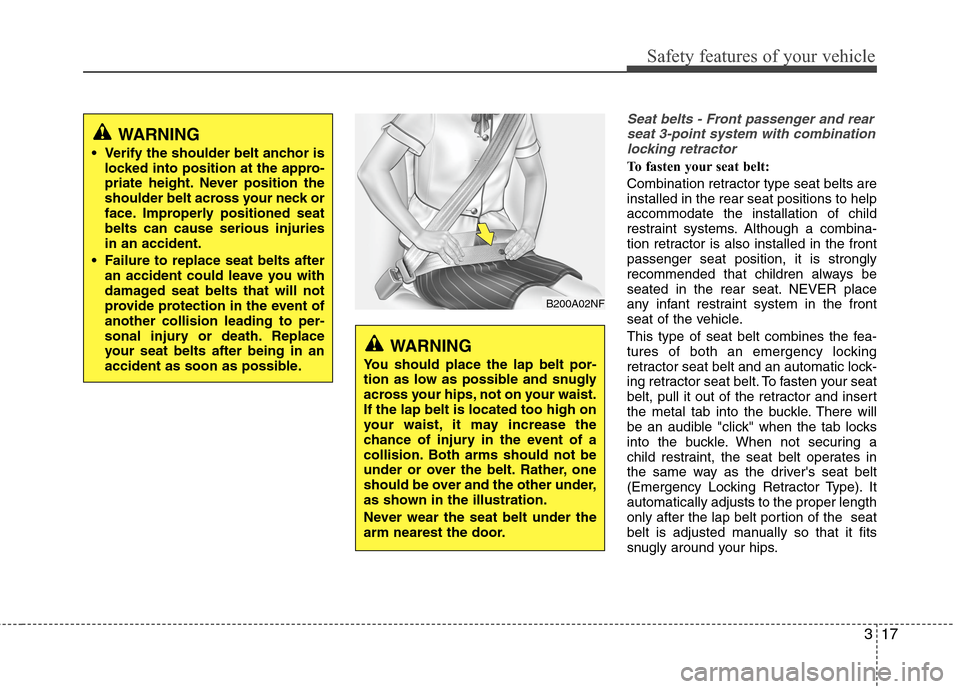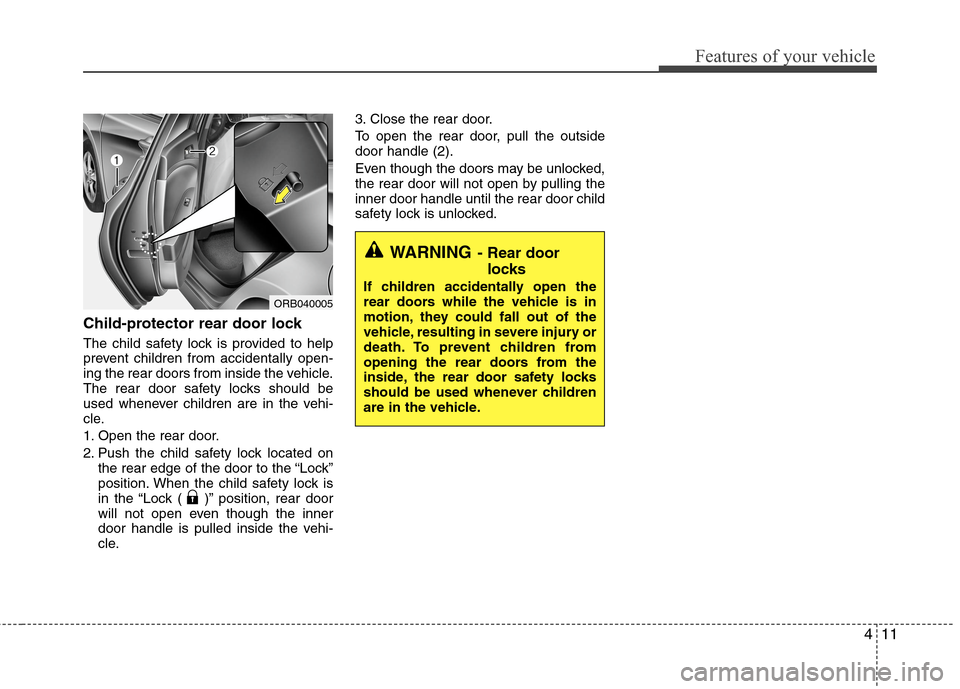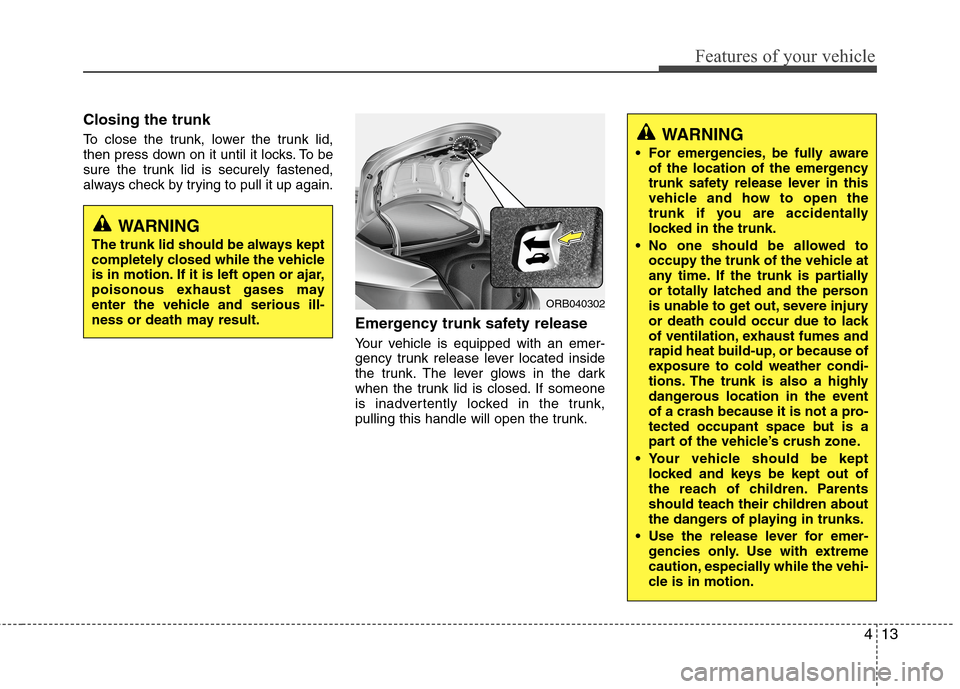2014 Hyundai Accent child locks
[x] Cancel search: child locksPage 34 of 406

317
Safety features of your vehicle
B200A02NF
WARNING
You should place the lap belt por-
tion as low as possible and snugly
across your hips, not on your waist.
If the lap belt is located too high on
your waist, it may increase the
chance of injury in the event of a
collision. Both arms should not be
under or over the belt. Rather, one
should be over and the other under,
as shown in the illustration.
Never wear the seat belt under the
arm nearest the door.
Seat belts - Front passenger and rear
seat 3-point system with combination
locking retractor
To fasten your seat belt:
Combination retractor type seat belts are
installed in the rear seat positions to help
accommodate the installation of child
restraint systems. Although a combina-
tion retractor is also installed in the front
passenger seat position, it is strongly
recommended that children always be
seated in the rear seat. NEVER place
any infant restraint system in the front
seat of the vehicle.
This type of seat belt combines the fea-
tures of both an emergency locking
retractor seat belt and an automatic lock-
ing retractor seat belt. To fasten your seat
belt, pull it out of the retractor and insert
the metal tab into the buckle. There will
be an audible "click" when the tab locks
into the buckle. When not securing a
child restraint, the seat belt operates in
the same way as the driver's seat belt
(Emergency Locking Retractor Type). It
automatically adjusts to the proper length
only after the lap belt portion of the seat
belt is adjusted manually so that it fits
snugly around your hips.
WARNING
Verify the shoulder belt anchor is
locked into position at the appro-
priate height. Never position the
shoulder belt across your neck or
face. Improperly positioned seat
belts can cause serious injuries
in an accident.
Failure to replace seat belts after
an accident could leave you with
damaged seat belts that will not
provide protection in the event of
another collision leading to per-
sonal injury or death. Replace
your seat belts after being in an
accident as soon as possible.
Page 88 of 406

411
Features of your vehicle
Child-protector rear door lock
The child safety lock is provided to help
prevent children from accidentally open-
ing the rear doors from inside the vehicle.
The rear door safety locks should be
used whenever children are in the vehi-
cle.
1. Open the rear door.
2. Push the child safety lock located on
the rear edge of the door to the “Lock”
position. When the child safety lock is
in the “Lock ( )” position, rear door
will not open even though the inner
door handle is pulled inside the vehi-
cle.3. Close the rear door.
To open the rear door, pull the outside
door handle (2).
Even though the doors may be unlocked,
the rear door will not open by pulling the
inner door handle until the rear door child
safety lock is unlocked.
ORB040005
WARNING- Rear door
locks
If children accidentally open the
rear doors while the vehicle is in
motion, they could fall out of the
vehicle, resulting in severe injury or
death. To prevent children from
opening the rear doors from the
inside, the rear door safety locks
should be used whenever children
are in the vehicle.
Page 90 of 406

413
Features of your vehicle
Closing the trunk
To close the trunk, lower the trunk lid,
then press down on it until it locks. To be
sure the trunk lid is securely fastened,
always check by trying to pull it up again.
Emergency trunk safety release
Your vehicle is equipped with an emer-
gency trunk release lever located inside
the trunk. The lever glows in the dark
when the trunk lid is closed. If someone
is inadvertently locked in the trunk,
pulling this handle will open the trunk.
ORB040302
WARNING
For emergencies, be fully aware
of the location of the emergency
trunk safety release lever in this
vehicle and how to open the
trunk if you are accidentally
locked in the trunk.
No one should be allowed to
occupy the trunk of the vehicle at
any time. If the trunk is partially
or totally latched and the person
is unable to get out, severe injury
or death could occur due to lack
of ventilation, exhaust fumes and
rapid heat build-up, or because of
exposure to cold weather condi-
tions. The trunk is also a highly
dangerous location in the event
of a crash because it is not a pro-
tected occupant space but is a
part of the vehicle’s crush zone.
Your vehicle should be kept
locked and keys be kept out of
the reach of children. Parents
should teach their children about
the dangers of playing in trunks.
Use the release lever for emer-
gencies only. Use with extreme
caution, especially while the vehi-
cle is in motion.
WARNING
The trunk lid should be always kept
completely closed while the vehicle
is in motion. If it is left open or ajar,
poisonous exhaust gases may
enter the vehicle and serious ill-
ness or death may result.
Page 237 of 406

511
Driving your vehicle
For smooth operation, depress the brake
pedal when shifting from N (Neutral) to a
forward or reverse gear.Transaxle ranges
The indicator in the instrument cluster
displays the shift lever position when the
ignition switch is in the ON position.
P (Park)
Always come to a complete stop before
shifting into P (Park). This position locks
the transaxle and prevents the drive
wheels from rotating.
WARNING- Automatic
transaxle
Always check the surrounding
areas near your vehicle for peo-
ple, especially children, before
shifting a car into D (Drive) or R
(Reverse).
Before leaving the driver’s seat,
always make sure the shift lever
is in the P (Park) position; then
set the parking brake fully and
shut the engine off. Unexpected
and sudden vehicle movement
can occur if these precautions
are not followed in the order iden-
tified.
CAUTION
To avoid damage to your
transaxle, do not accelerate the
engine in R (Reverse) or any for-
ward gear position with the
brakes on.
When stopped on an incline, do
not hold the vehicle stationary
with engine power. Use the serv-
ice brake or the parking brake.
Do not shift from N (Neutral) or P
(Park) into D (Drive), or R
(Reverse) when the engine is
above idle speed.
WARNING
Shifting into P (Park) while the
vehicle is in motion will cause the
drive wheels to lock which will
cause you to lose control of the
vehicle.
Do not use the P (Park) position
in place of the parking brake.
Always make sure the shift lever
is latched in the P (Park) position
and set the parking brake fully.
Never leave a child unattended in
a vehicle.
Page 400 of 406

I3
Index
Cargo capacity ·······························································5-43
Cargo weight ··································································5-47
Center console storage ···················································4-84
Central door lock switch··················································4-9
Certification label ··························································5-45
Certification label ····························································8-6
Chains
Tire chains ·································································5-39
Changing tires ································································6-18
Checking tire inflation pressure·····································7-38
Child restraint system ····················································3-26
Lower anchor ····························································3-32
Seat belt ·····································································3-27
Tether anchor system·················································3-30
Child-protector rear door lock ·······································4-11
Climate control air filter ················································4-73
Climate control air filter ················································7-28
Clock (Digital) ·······························································4-89
Clothes hanger ·······························································4-89
Combined instrument, see instrument cluster ···············4-36
Compact spare tire ·························································6-23
Compact spare tire replacement ····································7-42
Coolant ···········································································7-23
Cooling fluid, see engine coolant ··································7-23
Crankcase emission control system ·······························7-76
Cruise control system ····················································5-27
Cup holder ·····································································4-87
Curtain air bag ·······························································3-51Dashboard illumination,
see instrument panel illumination ·····························4-37
Dashboard, see instrument cluster ·································4-36
Defogging (Windshield) ················································4-81
Defogging logic (Windshield) ·······································4-83
Defroster (Rear window) ···············································4-64
Defrosting (Windshield) ················································4-81
Digital clock···································································4-89
Dimensions ······································································8-2
Display illumination, see instrument panel illumination··4-37
Displays, see instrument cluster ····································4-36
Door locks········································································4-7
Central door lock switch ·············································4-9
Child-protector rear door lock···································4-11
Drinks holders, see cup holders·····································4-87
Driver's 3-point seat belt················································3-16
Driver's and passenger's front air bag····························3-46
Driving at night······························································5-35
Driving in flooded areas ················································5-36
Driving in the rain ·························································5-36
Economical operation ····················································5-32
Electric power steering ··················································4-30
Electronic stability control (ESC) ·································5-21D
E